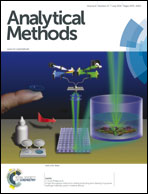A rapid and simple method to assess the changes of human VEGF mRNA based on dual molecular beacons†
Abstract
The vascular endothelial growth factor, or VEGF, is a key signal used by oxygen-hungry cells to promote growth of blood vessels and a key regulator of angiogenesis in a variety of physiological and pathological processes. It binds to specialized receptors on the surfaces of endothelial cells and directs them to build new vessels in vascular angiogenesis, and fulfills this role by modulating intracellular signaling and gene expression in response to chemical and physiological stimuli. Thus, assessing change of VEGF mRNA is essential to understand how physiological and pathological processes modulate angiogenesis. Here, dual molecular beacons were applied to detect the changes of VEGF mRNA in hepatocarcinoma cells with different treatments, an optimized hybridization assay for VEGF mRNA took ∼30 min to perform and levels of VEGF mRNA were further validated by real-time qRT-PCR. In addition, methods of RNase H digestion and blocking oligonucleotides were used to verify the reliability of the fluorescence change caused by the beacon–mRNA hybridization. Based on these findings, it can be concluded that the new method with advantages of simplicity, rapidity and efficiency has great promise for assessing gene expression analysis of clinical or other biological samples.


 Please wait while we load your content...
Please wait while we load your content...